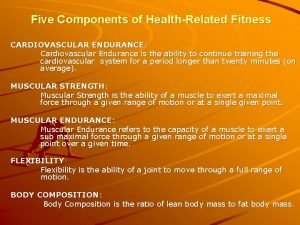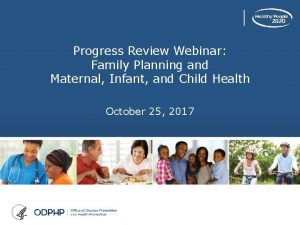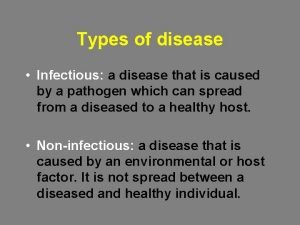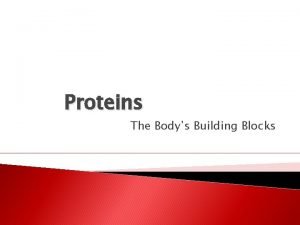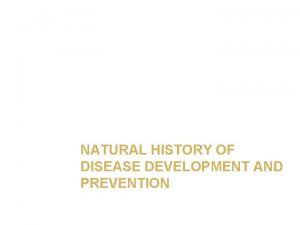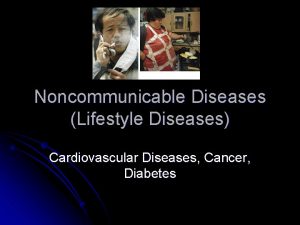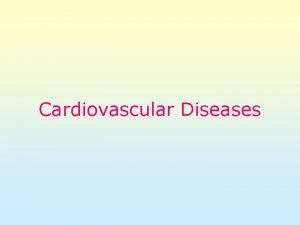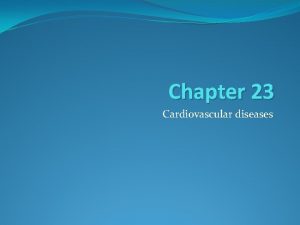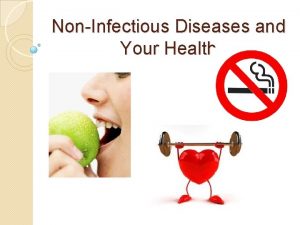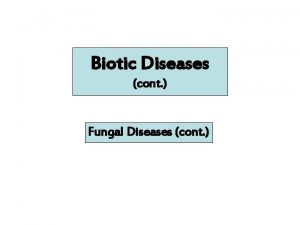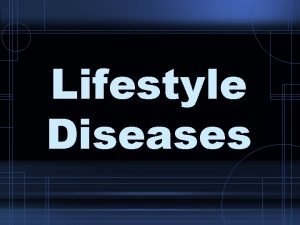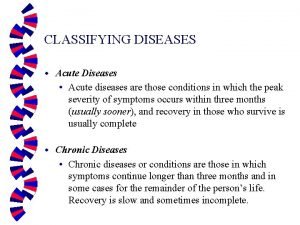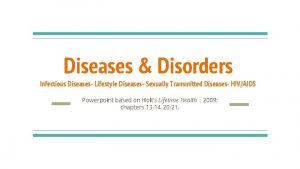MANAGING CARDIOVASCULAR HEALTH Cardiovascular diseases kill more women




















- Slides: 20

MANAGING CARDIOVASCULAR HEALTH Cardiovascular diseases kill more women than any other disease, including lung or breast cancer. 12/25/2021 MANAGING CARDIOVASCULAR HEALTH 1

FACTS ABOUT CVD • More prevalent in men ages 25 -40 yet more deadly in women • African American have greater risk for HBP, CAD, CHD, and highest rate of CVD death • Hispanic and Native American women have prevalence of diabetes due to obesity which is a controllable risk factor that leads to CVD • Because a woman’s heart and blood vessels are typically smaller, less plaque is needed for blockage 12/25/2021 MANAGING CARDIOVASCULAR HEALTH 2

ANATOMY OF THE HEART • • The heart is made up of 4 chambers Right and Left Atriums Right and Left Ventricles Tricuspid, Bicuspid, Aortic Valves The septum divides the heart into rt and lft sides It is a muscular organ @ the size of a mans fist The heart beats 100, 000 X/day at@ 72 BPM 12/25/2021 MANAGING CARDIOVASCULAR HEALTH 3

VASCULAR SYSTEM • The vascular system is comprised of 60, 000 miles of blood vessels • Aorta • Arteries • Arterioles • Vena Cava • Veins • Venules • Capillaries 12/25/2021 MANAGING CARDIOVASCULAR 4 HEALTH

COMPONENTS OF BLOOD • 4 -6 Quarts of blood are circulated through the blood vessels per day • RBCs carry O 2 and CO 2 • There are @ 4, 000 - 5, 000 per Cu. Mm • WBCs act as scavengers that rid the blood of bacteria and waste • There are @ 5, 000 -10, 000 and they make up the Immune system • Platelets aid in coagulation • Plasma is the liquid part of blood 12/25/2021 MANAGING CARDIOVASCULAR HEALTH 5

CIRCULATION OF BLOOD • Blood enters the Rt. Atrium via the SVC and IVC • It flows down through the tricuspid valve to the Lf. Ventricle where it passes through the pulmonary valve down to the lungs • Blood releases wastes an CO 2 and picks up O 2 and nutrients • It travels up to the Lf. Atrium down through the bicuspid valve to the Lf. Ventricle • Which is the most critical chamber of the heart • It is pumped out by the Aorta and circulates to all the cells of the body • Circulation depends on the normal electrical function of 12/25/2021 MANAGING CARDIOVASCULAR the hearts sinus rhythm HEALTH 6

TYPES OF HEART DISEASE • • ATHEROSCLROSIS ARTERIOSCLEROSIS HYPERTENSION CEREBROVASCULAR DISEASE • STROKE • CHF • ANGINA PECTORIS 12/25/2021 • CONGENITAL HD • PERIPHERAL ARTERY DISEASE • CAD • CHD • MYOCARDIAL INFARCTION • ARRYTHMIA • ENDOCARDITIS • SILENT ISCHEMIA MANAGING CARDIOVASCULAR HEALTH 7

HYPERLIPIDEMIA • High saturated fat in the blood • Cholesterol is a fat produced in the liver or small intestine and should remain below 200 in the blood count • It is necessary in the manufacture of hormones and nerve cell lining • Triglycerides are components of lipoproteins • Low density lipoproteins • Very low density lipoproteins 12/25/2021 MANAGING CARDIOVASCULAR HEALTH 8

ATHEROSCLEROSIS • • • Artery break down due to clogging Clogging is due to excess plaque Saturated fats penetrate arterial wall Muscle elasticity of the lumen degenerates Cholesterol and triglycerides are also responsible for the destruction of the artery • Arteriosclerosis is the hardening if the artery due to atherosclerosis and the damage is irreversible 12/25/2021 MANAGING CARDIOVASCULAR HEALTH 9

ANGINA PECTORIS • Angina is Greek for “to strangle” or mild clamping ache to crushing pain in chest • It is a cluster of symptoms associated with O 2 depravation • This is also ischemia which is lack of O 2 rich blood to the heart muscle • It is not an HA but could be a warning of CVD • Pain subsides once O 2 is replenished to muscle • May be mistaken for heartburn, gastric disorders, asthma, allergies and bronchitis • Nitroglycerin is the medication given because it is a vasodilator 12/25/2021 MANAGING CARDIOVASCULAR HEALTH 10

MYOCARDIAL INFARCTION • An embolism lodged in the coronary artery • Causes an occlusion and O 2 cannot reach the heart muscle • Pain in the chest is severe and crushing and cannot be helped by drugs • Section of heart muscle dies due to lack of O 2 or ischemia • Heart Attack or cardiac arrest is the result • An MI is more lethal to women 12/25/2021 MANAGING CARDIOVASCULAR HEALTH 11

STROKE • Cerebrovascular accident or stroke • Blood vessel damage caused by aneurysm, thrombus, or embolus • HBP or a congenital defect can also cause damage • Depending on what part of the brain that is blocked will determine whether speech, memory, thought, or movement are affected or lost • TIA’s transient ischemic attacks are minute strokes that are a warning sign that a stroke is eminent • Prevalent in white women over 45: Afro. Am. Women over 35 and 60% of all stroke deaths are women 12/25/2021 MANAGING CARDIOVASCULAR HEALTH 12

CONGESTIVE HEART FAILURE • • • Heart too weak to pump and circulate blood CHF represents a heart whose muscles are weak and flabby Poor circulation causes fluids to accumulate in veins Breathing problems result from too much fluid in the lungs Kidneys are impacted causing swelling in the extremities CHF is common in older women who suffer from HBP, Atherosclerosis, arteriosclerosis, or Congenital HD • Heart damage from Rheumatic Fever and bacterial diseases, HA(damage & scar tissue) • Symptoms include shortness of breath, dyspnea, edema 12/25/2021 MANAGING CARDIOVASCULAR HEALTH 13

PERIPHERAL ARTERY DISEASE • Disease of the extremities mostly of the legs • Diminished supply of blood to extremities due to atherosclerosis, arteriosclerosis, diabetes, smoking, or HBP • Clogging results in waste products not being properly eliminated from the body • Nutrients are not delivered to the cells • Cramping, numbness, and necrosis of the tissues could result in amputation 12/25/2021 MANAGING CARDIOVASCULAR HEALTH 14

SILENT ISCHEMIA • CVD has not historically been considered a woman’s disease only a man’s disease • Medical research has never focused on women and CVD • Mainly because older women suffer from other complicated medical problems • Silent HA can occur to women without any of the regular symptoms • Women are at greater risk from silent heart attacks • Women may have unspecified pain and a physician usually never suspects a HA 12/25/2021 MANAGING CARDIOVASCULAR HEALTH 15

CORONARY RISK FACTORS • An action or behavior that places an individual at a higher risk for developing a condition or a disease • The following are examples of risk factors: • Smoking • Stress • Obesity • Sedentary lifestyle • Oral Contraceptives • Menopause 12/25/2021 • • • Hypertension High Blood fats LDL’s bad cholesterol Triglycerides Diabetes Sex Race/ethnicity Age Heredity MANAGING CARDIOVASCULAR HEALTH 16

BLOOD PRESSURE • • • Blood pressure is a controllable risk factor It is measured with a spygmomanometer Systolic pressure measures heart contraction Diastolic pressure measures heart refill Smoking is a vasoconstrictor that narrows blood vessels and increases blood pressure • Pressure of 140/90 is considered borderline hypertension • BP is controlled by diet, wt management, and meds 12/25/2021 MANAGING CARDIOVASCULAR HEALTH 17

UNCONTROLLABLE RISK FACTORS • Heredity -family history and genetics • Race/Ethnicity e. g. Afro. Am. Women have the highest rate of CVD • Age- chronological not physiological • Sex- male or female • Post Menopause- woman’s chances of HA increase due to decreased estrogen and progesterone and the reduction of HDL’s and increase in LDL’s 12/25/2021 MANAGING CARDIOVASCULAR HEALTH 18

CONTRIBUTING FACTORS • Obesity -above 16% in men and 22% in women • A major factor in the development of CHD, diabetes, and HBP • Stress • Alcohol - excessive intake of 3 -5 drinks or more per day • High sodium intake • Oral contraceptives - link between Oral C’s and HA is difficult due to continued changes in estrogen dosages 12/25/2021 MANAGING CARDIOVASCULAR HEALTH 19

PROTECTIVE FACTORS • Exercise- regular and consistent • HDL/Cholesterol the higher the blood levels the better • HRT hormone replacement therapy • Low fat diet • HDL/Cholesterol ratio in blood is high • Moderate alcohol consumption not to exceed 2 drinks per day • Aspirin taken daily 12/25/2021 MANAGING CARDIOVASCULAR HEALTH 20
 Lirik lagu more more more we praise you
Lirik lagu more more more we praise you More more more i want more more more more we praise you
More more more i want more more more more we praise you Cardiovascular system diseases and disorders chapter 8
Cardiovascular system diseases and disorders chapter 8 Chapter 21 mental health diseases and disorders
Chapter 21 mental health diseases and disorders Helped byzantine women win more legal rights
Helped byzantine women win more legal rights What is cardiovascular endurance in health related fitness
What is cardiovascular endurance in health related fitness Women's health alliance
Women's health alliance Centro medico coachella thermal ca
Centro medico coachella thermal ca The more you take the more you leave behind
The more you take the more you leave behind The more you study the more you learn
The more you study the more you learn Aspire not to have more but to be more
Aspire not to have more but to be more Newton 1st law
Newton 1st law Knowing more remembering more
Knowing more remembering more The more i give to thee the more i have
The more i give to thee the more i have More choices more chances
More choices more chances Human history becomes more and more a race
Human history becomes more and more a race Types of diseases
Types of diseases American quality gurus
American quality gurus Protein deficiency diseases
Protein deficiency diseases What is natural history of disease
What is natural history of disease Modern lifestyle and hypokinetic diseases
Modern lifestyle and hypokinetic diseases





